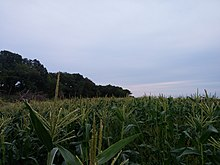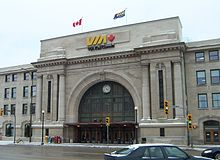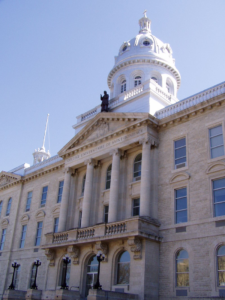
Manitoba is a province of Canada at the longitudinal center of the country. It is Canada’s fifth-most populous province, with a population of 1,278,365 as of 2016. The easternmost of the three prairie provinces, Manitoba covers 649,950 square kilometers of widely varied landscape, from arctic tundra and the Hudson Bay coastline in the north to dense boreal forest, large freshwater lakes, and prairie grassland in the central and southern regions. Manitoba’s capital and largest city is Winnipeg, the seventh most populous municipality in Canada. Winnipeg is the seat of government, home to the Legislative Assembly of Manitoba and the Provincial Court. Four of the province’s five universities, all four of its professional sports teams, and most of its cultural activities (including Festival du Voyageur and Folklorama) are located in Winnipeg.
The Manitoba Legislative Building
Manitoba has an extreme continental climate. Temperatures and precipitation generally decrease from south to north and increase from east to west. Manitoba is far from the moderating influences of mountain ranges or large bodies of water. Because of the generally flat landscape, it is exposed to cold Arctic high-pressure air masses from the northwest during January and February. In the summer, air masses sometimes come out of the Southern United States, as warm humid air is drawn northward from the Gulf of Mexico. Temperatures exceed 30 °C (86 °F) numerous times each summer, and the combination of heat and humidity can bring the humidex value to the mid-40s. Carman, Manitoba, recorded the second-highest humidex ever in Canada in 2007, with 53.0. According to Environment Canada, Manitoba ranked first for clearest skies year round and ranked second for clearest skies in the summer and for the sunniest province in the winter and spring.

Photo: Corn field in southern Manitoba
Manitoba has a moderately strong economy based largely on natural resources. Manitoba’s economy relies heavily on agriculture, tourism, electricity, oil, mining, and forestry. Agriculture is vital and is found mostly in the southern half of the province, although grain farming occurs as far north as The Pas. The most common agricultural activity is cattle husbandry, followed by assorted grains and oilseed. Manitoba is the nation’s largest producer of sunflower seed and dry beans, and one of the leading sources of potatoes. Portage la Prairie is a major potato processing center. Richardson International, one of the largest oat mills in the world, also has a plant in the municipality.
Manitoba’s largest employers are government and government-funded institutions, including crown corporations and services like hospitals and universities. Major private-sector employers are The Great-West Life Assurance Company, Cargill Ltd., and Richardson International. Manitoba also has large manufacturing and tourism sectors. Churchill’s Arctic wildlife is a major tourist attraction; the town is a world capital for polar bear and beluga whale watchers. Manitoba is the only province with an Arctic deep-water seaport, at Churchill.

Photo: Union Station Winnipeg
Winnipeg James Armstrong Richardson International Airport, Manitoba’s largest airport, is one of only a few 24-hour unrestricted airports in Canada and is part of the National Airports System.
Manitoba has two Class I railways: Canadian National Railway (CN) and Canadian Pacific Railway (CPR). Winnipeg is centrally located on the main lines of both carriers, and both maintain large inter-modal terminals in the city. Via Rail offers transcontinental and Northern Manitoba passenger service from Winnipeg’s Union Station. Numerous small regional and short-line railways also run trains within Manitoba: the Hudson Bay Railway, the Southern Manitoba Railway, Burlington Northern Santa Fe Manitoba, Greater Winnipeg Water District Railway, and Central Manitoba Railway.

Photo: University de Saint-Boniface
Public schools follow a provincially mandated curriculum in either French or English. There are sixty-five funded independent schools in Manitoba, including three boarding schools. These schools must follow the Manitoban curriculum and meet other provincial requirements. There are forty-four non-funded independent schools, which are not required to meet those standards. Public schools in Manitoba fall under the regulation of one of thirty-seven school divisions within the provincial education system (except for the Manitoba Band Operated Schools, which are administered by the federal government).
University in Manitoba
There are five public universities and one private university in Manitoba, which are under the responsibility of the Ministry of Advanced Education and Literacy. Three of the public universities—the University of Manitoba, which is the oldest university in western Canada, the University of Winnipeg, and Université de Saint-Boniface—are in Winnipeg, the capital and largest city in the province. Université de Saint-Boniface, established in 1818, is the oldest post-secondary institute in the province and is the only French-language University in western Canada. Brandon University is located in the western Manitoba city of Brandon. Canadian Mennonite University is a private Anabaptist university in Winnipeg.
The province also has three university college: Booth University College, formed in 1982, in Winnipeg, Providence University College in Otterburne, Manitoba, and the University College of the North, which serves the communities of The Pas and Thompson. Smaller satellite campuses serve 12 other smaller centers, 9 of which are on First Nations.
University enrolment in Manitoba ranges from Booth University College with several hundred students to the University of Manitoba with 26,800 students
Manitoba Colleges
Assiniboine Community College
Red River College
Robertson College
University College of the North
Manitoba Institute of Trades and Technology
Source of the majority of Photos and Content of this page: Wikipedia
It is your duty in life to save your dream
AMEDEO MODIGLIANI